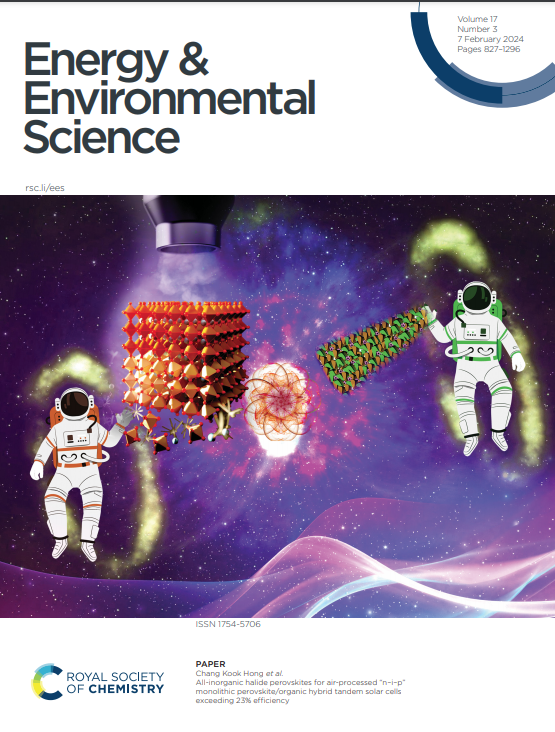富勒烯包埋卟啉金属镀层作为稳定二元有机太阳能电池的光活性添加剂,效率达到20.2%
IF 30.8
1区 材料科学
Q1 CHEMISTRY, MULTIDISCIPLINARY
引用次数: 0
摘要
提高功率转换效率(PCE)和稳定性对于有机太阳能电池(OSCs)的实际应用至关重要。在这里,我们使用富勒烯包埋的卟啉金属镀层(MC4、C60和MC4、C70)作为光活性添加剂,协同提高了OSCs的PCE和稳定性。与不含富勒烯的卟啉金属镀层(MC4)和MC4、C60相比,MC4、C70具有优越的光响应活性、多阶段结晶以及与供体(PM6)和受体(eC9-4ClO)的非共价相互作用。因此,MC4、c70处理的活性层获得了更好的光子捕获能力和优化的共混形态,具有理想的结晶度、分子间π-π堆叠和相分离,最终降低了陷阱密度,促进了激子的产生和解离,改善了电荷收集,限制了电荷重组。结果,与无金属(19.88%)、MC4(19.16%)和MC4、C60(20.09%)处理的OSCs相比,MC4、c70处理的OSCs提供了20.42%的更高的PCE。值得注意的是,冠军osc的认证PCE达到20.20%,是二进制osc的最高认证值之一。令人印象深刻的是,MC4、c70处理的器件还提供了卓越的长期运行稳定性,在最大功率点跟踪500小时下,初始PCE的保留率为~90%。这项工作开辟了一条新的途径,使用富勒烯嵌入的卟啉金属作为光活性添加剂来操纵光电和形态特性,以实现高效和稳定的osc。本文章由计算机程序翻译,如有差异,请以英文原文为准。
Fullerene-Embedded Porphyrin Metallacages as Photoactive Additives for Stable Binary Organic Solar Cells with a Certificated Efficiency of 20.2%
Boosting both power-conversion-efficiency (PCE) and stability are crucial for the practical applications of organic solar cells (OSCs). Here, we synergistically improve PCE and stability of OSCs using fullerene-embedded porphyrin metallacages (MC4⊃C60 and MC4⊃C70) as photoactive additives. Compared to fullerene-free porphyrin metallacage (MC4) and MC4⊃C60, MC4⊃C70 has superior photo-responsive activity, multistage crystallization, and extraordinary non-covalent interactions with both donor (PM6) and acceptor (eC9-4ClO). Therefore, the MC4⊃C70-treated active layer obtains improved photon harvesting capability and optimized blend morphology with ideal crystallinity, intermolecular π-π stacking, and phase separation, eventually diminishing trap density, facilitating exciton generation and dissociation, improving charge collection, and limiting charge recombination. As a result, the MC4⊃C70-treated OSCs provide a higher PCE of 20.42% compared to those metallacage-free (19.88%), MC4 (19.16%), and MC4⊃C60 (20.09%) treated OSCs. Notably, the champion OSCs achieve a certified PCE of 20.20%, ranking among the highest certified values for binary OSCs. Impressively, the MC4⊃C70-treated devices also offer superior long-term operation stability with a ~90% retention of the initial PCE under maximum-power-point tracking for 500 h. This work opens a new avenue of using fullerene-embedded porphyrin metallacages as photoactive additives to manipulate the optoelectronic and morphological properties for realizing efficient and stable OSCs.
求助全文
通过发布文献求助,成功后即可免费获取论文全文。
去求助
来源期刊

Energy & Environmental Science
化学-工程:化工
CiteScore
50.50
自引率
2.20%
发文量
349
审稿时长
2.2 months
期刊介绍:
Energy & Environmental Science, a peer-reviewed scientific journal, publishes original research and review articles covering interdisciplinary topics in the (bio)chemical and (bio)physical sciences, as well as chemical engineering disciplines. Published monthly by the Royal Society of Chemistry (RSC), a not-for-profit publisher, Energy & Environmental Science is recognized as a leading journal. It boasts an impressive impact factor of 8.500 as of 2009, ranking 8th among 140 journals in the category "Chemistry, Multidisciplinary," second among 71 journals in "Energy & Fuels," second among 128 journals in "Engineering, Chemical," and first among 181 scientific journals in "Environmental Sciences."
Energy & Environmental Science publishes various types of articles, including Research Papers (original scientific work), Review Articles, Perspectives, and Minireviews (feature review-type articles of broad interest), Communications (original scientific work of an urgent nature), Opinions (personal, often speculative viewpoints or hypotheses on current topics), and Analysis Articles (in-depth examination of energy-related issues).
 求助内容:
求助内容: 应助结果提醒方式:
应助结果提醒方式:


